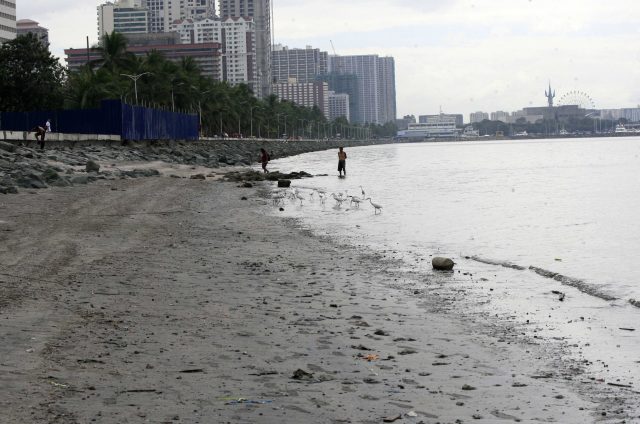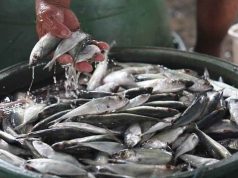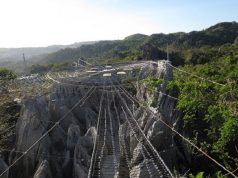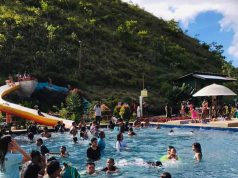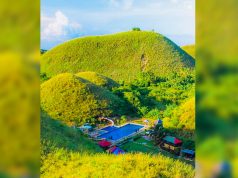Palace viewed the criticisms against the Manila Bay project as a smear campaign against the Duterte administration despite possible environmental and health risks to the residents who live nearby.
The Department of Environment and Natural Resources is recently in hot water over its Manila Bay “white sand” project worth a hefty P349 million. The agency sought to fill 500 meters stretch of the bay walk on Roxas Boulevard with pulverized dolomite rocks from Cebu amid the novel coronavirus pandemic.
This initiative is part of its plan to revive the Manila Bay Rehabilitation Program, which was launched in 2017.
Such initiative earned severe backlash from environmental groups and other concerned Filipinos, including Vice President Leni Robredo who argued that the budget could have been directed to the government’s pandemic response.
Last Thursday, September 17, Regine Nequia, the president of Baseco Seaside Neighborhood Association (BASA), posted photos and videos on Facebook of hundreds of dead fish floating in Manila Bay near the Baseco seawall.
Nequia speculated that the agency’s project might have caused the fish kill.
“Ngayon ka mapapaisip…namumuti yung dagat tapos ang daming patay na isda, saan to galing?” she said.
Ngayon ka mapapaisip.. namumuti yung dagat tapos ang daming patay na isda, saan to galing?😢
Posted by Ghine Nequia on Wednesday, September 16, 2020
This post was then uploaded on the Facebook page of a nonprofit organization called Urban Poor Associates that demanded the government to probe into the matter, citing the 22,000 families in Baseco who are dependent on fishing.
Regine Nequia, president of Baseco Seaside Neighborhood Association (BASA) was surprised to see dead fish floating on…
Posted by Urban Poor Associates on Wednesday, September 16, 2020
The government’s response
In a press briefing on Friday, September 18, presidential spokesperson Harry Roque questioned the timing of the fish kill incident and said that it could be an attack against President Rodrigo Duterte.
“So ingat-ingat lang po tayo sa panahon ngayon desperado po ang kalaban ng gobyerno, lahat po ginagawa para siraan si Presidente Duterte,” Roque said.
“At nagpapasalamat po kami kahit anong sabihin nila, kahit anong gawin nila, nagtitiwala pa rin po ang sambayanang Pilipino kay Presidente Duterte,” he added.
Roque also questioned reports that tilapia was found among the dead fishes and claimed that the fish species could only breed in freshwater.
While they mainly thrive in freshwater, tilapia fishes could also breed and thrive in brackish or saltwater.
“Bakit ang tilapia, freshwater fish iyon, nakarating sa Manila Bay? Parang imposible naman iyon ‘no dahil hindi po mabubuhay ang tilapia sa saltwater,” he said.
On Friday, DENR Undersecretary Benny Antiporda performed an experiment in front of reporters where he took samples of the dolomite sand in an aquarium of gold fishes as an attempt to prove that the recent fish kill is not connected to the ongoing beautification project.
DENR Usec. Antiporda placed dolomite sand in an aquarium with fish to prove that the recent fishkill in Baseco was not caused by the sand in Manila Bay.
Sec. 6 of the Animal Welfare Act prohibits the use of animals in 'experiments not expressly authorized by CAW.'
📷 Boy Santos pic.twitter.com/nUdpjJ3My1
— Philstar.com (@PhilstarNews) September 18, 2020
Some Filipinos criticized the aquarium setup citing that it’s nothing like Manila Bay.
“Wrong set up. The water used in this aquarium is fresh, the fish used is gold fish and is not the same as the actual fishes that were killed,” one user said.
“Parang di to papasa sa thesis defense,” Dr. Jai Cabajar quipped.
Content creator Macoy Averilla or Macoy Dubs, also a fish keeper, shared his knowledge on fishes under unstable water parameters.
“Sis, I am a fishkeeper for 17 years and trust me namamatay ang isda kapag unstable ang water parameters. Be it ammonia poisoning, nitrate/nitrite spike. Dolomite interrupts water PH levels,” Averilla said.
Another user, meanwhile, noted that dolomite might not have directly caused the fish kill, but it also did not prevent the incident from happening.
“Just tells you that you are NOT solving any of the root causes of the problems in Manila Bay. Worse, the nourishment might be confounding it,” the user wrote.
In a previous press briefing, Antiporda also denied the assumptions of UPA and Nequia that the dolomite was linked to the deaths of the fishes, calling it “impossible.”
“As of now, what I’m saying is that’s unlikely and the allegation that the fish kill came from the nourishment area is erroneous,” he said.
What environmentalists are saying
In a statement on September 17, fisherfolk rights group Pamalakaya Pilipinas stressed that fish kills are proofs that the Manila Bay is already too “degraded,” a concern which the DENR should have been addressing.
“This fish kill is an indication that Manila Bay is degraded as it is. It is supposed to be the main concern that DENR should be seriously addressing, not busying itself with some kind of ‘beach nourishment’ that is actually ephemeral aesthetics but irrelevant to rehabilitation,” the group said.
This fish kill is an indication that Manila Bay is degraded as it is. It is supposed to be the main concern that DENR should be seriously addressing, not busying itself with some kind of “beach nourishment” that is actually ephemeral aesthetics but irrelevant to rehabilitation. https://t.co/UlplgcPY2x
— Pamalakaya Pilipinas (@pama_pil) September 17, 2020
They called on the department and the Bureau of Fisheries and Aquatic Resources to focus on rehabilitating and restoring Manila to prevent such phenomenon again.
Twitter page Mangingisda Says, an advocate of sea conservation, also speculated water pollution as the cause of the fishes’ deaths and therefore, warrants a thorough investigation from government agencies.
“There’s also the possibility na pollution mula sa ilalim ng dagat ang dahilan. Probably after umulan, lumamig ang surface waters at umakyat ang tubig mula sa ilalim, bringing toxic chemicals,” the user wrote.
We need an aerial view para malaman if ang cause ng turbidity ng dagat ay ang dolomite. There's also the possibility na pollution mula sa ilalim ng dagat ang dahilan. Probably after umulan, lumamig ang surface waters at umakyat ang tubig mula sa ilalim, bringing toxic chemicals. https://t.co/uy1o5Ktg0A
— Mangingisda #SaveTaliptip (@MangingisdaSays) September 17, 2020

